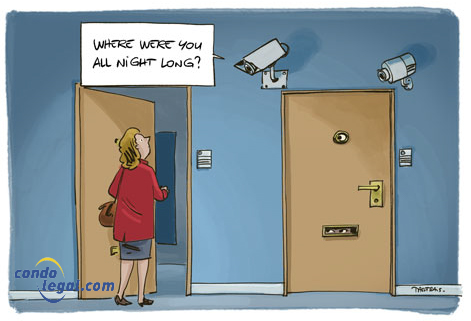Harassment in co-ownership
 Harassment in co-ownership can take many forms and develop in a wide variety of contexts. When occupants of a building with very different temperaments share a place to live, it happens that the spirits heat up to the point of making cohabitation impossible. A co-owner who infringes on his neighbor's privacy and interferes in his privacy can be particularly irritating and even embarrassing. If he comes to photograph him when he walks through the common portions, monitors all his comings and goings or installs a surveillance camera in the corridor pointing towards his front door, then there is an illegitimate invasion of his privacy. Such serious conduct can be considered psychological harassment, in that it seriously harms the person who is the victim.
Harassment in co-ownership can take many forms and develop in a wide variety of contexts. When occupants of a building with very different temperaments share a place to live, it happens that the spirits heat up to the point of making cohabitation impossible. A co-owner who infringes on his neighbor's privacy and interferes in his privacy can be particularly irritating and even embarrassing. If he comes to photograph him when he walks through the common portions, monitors all his comings and goings or installs a surveillance camera in the corridor pointing towards his front door, then there is an illegitimate invasion of his privacy. Such serious conduct can be considered psychological harassment, in that it seriously harms the person who is the victim.
Good neighbourliness and tolerance
Living in co-ownership requires a certain tolerance and being diplomatic in your spare time. You have to know how to live with people who do not necessarily have the same ideas as you, the same vision of things, the same education or even the way of life. In this regard, article 976 of the Civil Code of Quebec provides that " Neighbours shall suffer the normal neighbourhood annoyances that are not beyond the limit of tolerance they owe each other, according to the nature or location of their land or local usage. ".
T hus, a co-owner of an apartment in an urban environment cannot display a zero-tolerance threshold for noise. He cannot expect to benefit from the sound calm of a rural or isolated environment. His intransigence does not allow him to threaten his neighbors with the intervention of the police in order to intimidate them. They, out of good neighbourliness, certainly do not have an obligation to tolerate unreasonable complaints or threats.
Harassment
Neighborhood conflicts in co-ownership are numerous and can sometimes degenerate into situations of harassment, which should not – in any case – be considered normal. A co-owner who uses intimidation or harasses his neighbor will be considered an abnormal inconvenience. Harassment manifests itself in various forms: moral, physical, sexual. The systematic observation of the actions of an occupant of the building in a sustained manner, the verbal invective (insults, vexations) recurrent about points of disagreement (implementation of the declaration of co-ownership, execution of work, acoustic problem, etc.) are elements that can be the source of untimely gestures. For example, the fact that a co-owner constantly calls the directors to make unreasonable and unfounded complaints about his neighbor can constitute a form of harassment. Note that any other repeated act aimed at harm could be considered so.
Civil liability
There are several pieces of legislation that deal with this type of situation. The Civil Code of Québec states that:
6. Every person is bound to exercise his civil rights in accordance with the requirements of good faith.
7. No right may be exercised with the intent of injuring another or in an excessive and unreasonable manner, and therefore contrary to the requirements of good faith.
The Charter of human rights and freedoms states that everyone has the right to the safeguard of his or her dignity, honour and reputation, as well as to respect for his or her private life. Thus, it is possible for any victim to argue that the harassing co-owner infringes his right to respect for his private life, to the safeguarding of his dignity, his honor and his reputation. He may also invoke the failure to respect his right to the peaceful enjoyment and free disposal of his property, as protected by Article 6 of the Charter.
In the event of abuse, a co-owner who is the victim of harassment may claim punitive damages for infringement of his or her fundamental rights, as permitted by section 49 of the Charter of human rights and freedoms. However, it must be remembered that the burden of proof lies with the person who wishes to establish a fact or right as specified in article 2803 of the Civil Code of Quebec. Above all, it is necessary to prove the facts of harassment, which can sometimes be difficult. To do this, a fact or event must be reported by the person who personally observed it (testimonial evidence), recounting what he saw or heard (article 2843 of the Civil Code of Quebec) with the greatest possible acuity. Claiming that a neighbour is a harasser may not be enough. Any element can be examined: letters and emails addressed, damage committed, testimonies of third parties or other neighbors, texts, surveillance camera, etc.
 WHAT YOU SHOULD KNOW! Conflicts between co-owners and directors can, very often, find their appeasement in communication. While this is sometimes easier said than done, it's better (at the very least) to try this avenue, instead of ending up in court with all the negative repercussions that entails.
WHAT YOU SHOULD KNOW! Conflicts between co-owners and directors can, very often, find their appeasement in communication. While this is sometimes easier said than done, it's better (at the very least) to try this avenue, instead of ending up in court with all the negative repercussions that entails.
 WHAT TO KEEP IN MIND: Harassment is defined as repeated violence that can be verbal, physical or psychological, aimed at psychologically unbalancing the person who suffers from it. This violence can be found in the relationships between co-owners and directors, and also within a board of directors.
WHAT TO KEEP IN MIND: Harassment is defined as repeated violence that can be verbal, physical or psychological, aimed at psychologically unbalancing the person who suffers from it. This violence can be found in the relationships between co-owners and directors, and also within a board of directors.
 WARNING! The consequences of harassment can be physical and psychological. Anxiety, sleep disorders, loss of self-confidence, depression are symptoms of stress associated with psychological harassment.
WARNING! The consequences of harassment can be physical and psychological. Anxiety, sleep disorders, loss of self-confidence, depression are symptoms of stress associated with psychological harassment.
Back to the factsheets